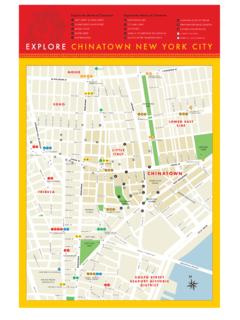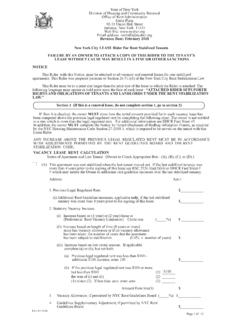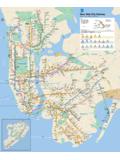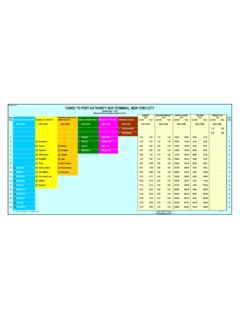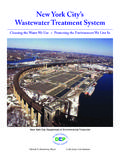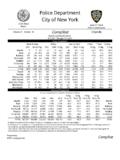Transcription of CHINATOWN NEW YORK CITY - explore chinatown …
1 CHINATOWN NEW york city . FACT SHEET. Size and Location: CHINATOWN New york city is the biggest in the United States, with the largest concentration of Chinese in the Western Hemisphere. It is located on the Lower East Side of Manhattan. With an area covering two square miles, CHINATOWN is home to a resident population estimated at 150,000. Manhattan's CHINATOWN is loosely bounded by Lafayette, Worth, Grand and East Broadway streets. Nationalities: CHINATOWN is a surprisingly diverse neighborhood. Since the 1800's the area today called CHINATOWN has been home to the highest number of immigrants in New york , representing a variety of ethnic groups. In the mid-1800's, the Irish, Germans, and freed slaves resided here and by the late 1880's and into early 1900's the next wave of immigrants brought Eastern European Jews, Chinese, and Italians. Today, the majority of CHINATOWN 's inhabitants are from the Guangdong, Toisan and Fujian Providences in China as well as Hong Kong.
2 The Cantonese community today is well established in this area whereas the Fujianese people, who come from Fujian Province on the southern coast of mainland China, are considered the new immigrants . The neighborhood is also home to Dominicans, Puerto Ricans, Burmese, Vietnamese, Filipinos and West Africans, among others. History: The Chinese first arrived in the US in the early 1800s. Many of these new immigrants worked during the gold rush in mining, manufacturing, and building railroads. The Chinese in the , were largely self-supporting, with a growing internal structure of governing associations and businesses that provided jobs, economic aid, social services and protection. Life became more difficult with the enactment of the Chinese Exclusion Act (1882-1943), limiting the growth of CHINATOWN . CHINATOWN has been growing steadily since the elimination of the immigration quota in 1968. Today CHINATOWN is home to hundreds of garment factories that have an annual payroll bill of over $200.
3 Million, a jewelry district that rakes in approximately a $100. million in gold and diamond sales per year, over 200 restaurants that attract thousands of tourists, and 27 banks, by far the highest bank-per-capita ratio in the city . -more- CHINATOWN FACT SHEET / 2. Food and Dining: Types of Cuisine Unbeknownst to many, over 10 distinct Asian fares grace CHINATOWN 's exciting, narrow streets. Not sure what you're hungry for? After passing dozens of tempting eateries in just a few short blocks, you sure will be. Cantonese, Shanghainese, Szechuan . and those are just the Chinese cuisines! Thai, Singaporean, Japanese, Indonesian, Asian fusion and others round out a list of fares representing a gastronomic dream for lovers of Asian cuisine. Dim Sum In Chinese, it means a little bit of heart and is the Cantonese term for small dishes. Dim sum usually takes place as a morning or early afternoon meal with family or friends. There are literally hundreds of different kinds of dim sum meat, fish, vegetarian usually prepared by steaming or frying.
4 Dim sum is usually served in small portions with three or four pieces that diners can select from a menu or from mobile carts that go from table to table through the restaurant, as each item emerges freshly prepared from the kitchen. Bakeries From sweet to savory, meat-filled, red-bean flavored or made with coconut, there is a unique taste for every palate when it comes to Chinese pastries. Typically, the sweet aroma of a CHINATOWN bakery can be sensed even before the store is in sight. Tea Houses An integral part of everyday life for the Chinese, tea houses offer visitors a place to relax and re-charge after walking and shopping in CHINATOWN . Try different varieties of Chinese tea and enjoy a snack at the same time. Shopping: CHINATOWN New york city is a shoppers paradise. The amazing variety of goods ranges from affordable gifts and treasures to ancient antiques and fine jewelry. Shops include: bakeries, electronic goods retailers, fashion boutiques, gift shops, general stores and malls, jewelry, markets with fresh produce such as seafood, Chinese traditional medicine, martial arts supplies, supermarkets, and tea houses.
5 Landmarks and Attractions: CHATHAM SQUARE (off Bowery and Worth Street), also known as Kim Lau Square is the site of the Kim Lau Memorial Arch found in the middle of the square. It was erected in 1962 in memory of the Chinese Americans who died during WWII. East of the square on Division Street is Confucius Plaza, where a statue of the philosopher stands. FIRST SHEARITH ISRAEL CEMETARY is just south of Chatham Square. It is the oldest cemetery and artifact in New york city , dating back to 1683. FUJIANESE EAST BROADWAY is the heart of the new Fujianese community. In this three-block area around the Manhattan Bridge there are Fujianese rice-noodle shops, herbal medicine shops, fresh markets and hair salons. -more- CHINATOWN FACT SHEET / 3. Landmarks and Attractions (continued): DOYERS STREET is a picturesque narrow elbow-shaped street just north of Chatham Square. It has been featured in numerous movies and TV shows. MOTT STREET is where visitors can truly feel the hustle and bustle of CHINATOWN .
6 A plethora of banners and signs with Chinese writing, some of CHINATOWN 's most popular restaurants and shops, and the rhythms of Mandarin and Cantonese dialects fill this narrow street. The oldest street in CHINATOWN inhabited by the Chinese, it is also the site of the Chinese Community Center and the Eastern States Buddhist Temple of America. The street is also home to 32. Mott Street (where the oldest shop in CHINATOWN used to stand . established in 1891), and 41 Mott Street (the only building that remains with a wooden pagoda roof). FIVE POINTS (at the intersection of Mosco, Worth and Baxter Streets), it was named for the intersection of the five streets that converged at the south end of what is now Columbus Park. It is was also the site of the city 's first tenements built to accommodate immigrants from Germany and Ireland. MUSEUM OF CHINESE IN THE AMERICAS offers special exhibitions on the history of the Chinese in the Exhibits feature personal stories, photographs, mementos, and poetry.
7 COLUMBUS PARK, situated just half a block south of the museum, is CHINATOWN 's major park. Created by Jacob Riis, a social reformer in the late 1890s, the public space is used by groups practicing tai chi, mahjong players, children and elderly men and their pet birds. On some weekends fortunetellers can be found here as well. PELL STREET is nicknamed Haircut Street because of a multitude of barber and beauty shops found here. The headquarters of the Hip Sing Business Association is located on this street and a Buddhist Temple is just a stone's throw away. This temple is mainly for visitors; worshipping Chinese opt for more secluded and quieter temples. EDWARD MOONEY HOUSE is the oldest residence in New york and is found on at the corner of Bowery and Pell Street. Built in 1785 by Edward Mooney, an amateur butcher, today it houses the Summit Mortgage Bank. CHURCH OF THE TRANSFIGURATION was erected in 1801. by the English Lutheran Church and sold to the Roman Catholic Church of the Transfiguration in 1853.
8 It served as a place for new immigrants to become adjusted to their new lives and today offers services in Cantonese, Mandarin, and English. -more- FACT SHEET / 4. Festivals: Chinese New Year (typically takes place between the months of January and February. The biggest holiday of the year, homes are adorned in red and gold and children are given lai see red packets filled with money for good luck). The Lantern Festival (is part of the Chinese New Year celebrations; traditionally this is the day when Chinese dragon and lion dances are held and lanterns are hung in the streets and in homes). Ghost Festival (celebrated on the 15th day of the seventh lunar month; on this day, traditional Chinese families burn special paper money and other offerings to appease the spirits). Mid-Autumn Festival (celebrated on the 15th day of the 8th lunar month; this is the day when the moon appears to be the fullest to the eye, and moon-cakes are given as gifts and eaten on this day).
9 Chung Yang or Double Yang Festival (observed on the ninth day of the ninth lunar month; this is the day when Chinese people visit their ancestors' graves to pay respect and engage in rituals of sacrifice). Nightlife: One of CHINATOWN 's best-kept secrets is its nightlife with bars, karaoke lounges, comedy clubs and late-night restaurants. Perfect for night owls, most of these places stay open until the wee hours of the morning. Walking Tours: Bus tours of New york city merely drive past the perimeter of CHINATOWN . The best way to see CHINATOWN is with a walking tour. Tours are available from: Experience CHINATOWN Walking Tour begins at MoCA, 70. Mulberry Street, 2nd Floor. Advance registration required. For further information, please call 212-619-4785. Jami Gong, a licensed NYC tour guide and popular local comedian, conducts walking tours featuring the area's historic and cultural attractions as well as tours combined with a tea ceremony, dim sum meal or Chinese feast.
10 For more information, see Big Onion Walking Tours Spring through Autumn Several tours include CHINATOWN historical sites, the Kimlau Memorial, and the Museum of the Chinese in the Americas. For further information, visit or call 212-439-1090. (are they licensed?). Joyce Gold History Tours of New york offers a public Gangs of New york walking tour. Call or visit online for appointments. For more information, call 212-242-5762 or visit Accommodations: In CHINATOWN : Holiday Inn Downtown 138 Lafayette Street at Howard Tel: 212-966-8898 or 1-(800)-HOLIDAY. Approximately: $149-$189. single or double. Within a mile of CHINATOWN : Tribeca Grand Hotel/Soho Grand Hotel 1 Avenue of the Americas / 310 W. Broadway, Tel: 212-519-6600 / 212-965-3000. Approximately: $299 single and double. - more - CHINATOWN FACT SHEET / 5. Accommodations (continued): Off Soho Suites 11 Rivington Street, Tel: 212-979-9808. Approximately: $79-$159 single or double.
